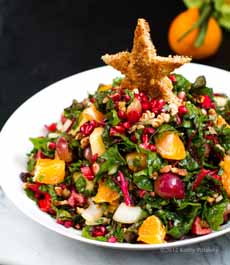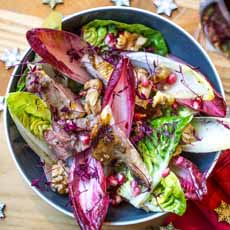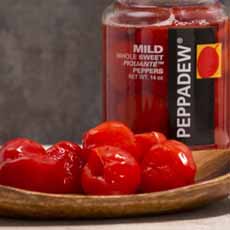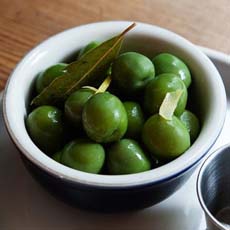TIP OF THE DAY: Christmas Salads
|
As we close in on Christmas, we like to “Christmas-ize” our food, adding red and green garnishes to everything from scrambled eggs (green and red bell peppers or jalapeños) to desserts (mint leaves and raspberries).
We have fun looking for a different red and green combination at every meal. The popular Caprese Salad is certainly red and green enough, but in the winter, when conventional tomatoes are out of season, you need to substitute: cherry or grape tomatoes, marinated sundried tomatoes, peppadews, pimientos (jarred red peppers), red bell peppers, etc. You can serve something as simple as a beet and avocado salad. No prep is required, beyond slicing the avocado. The peeled, cooked ready-to-eat beets from Love Beets and other brands are terrific. Then, just assemble the first three ingredients and drizzle the dressing (or place the dressing on the plate first). The original meaning of salad in European cuisine referred to a cold dish consisting of vegetables—lettuce, tomatoes, and cucumbers—topped with a dressing. Sometimes it containing seafood, meat, or eggs (think egg salad, tuna salad, etc.). The modern word, which entered Middle English around 1350-1400, derives from the French salade, which dates back to the Latin salata, salty. Since Roman times, vegetables were seasoned with brine or salty oil-and-vinegar dressings. The ancient Greeks and Romans alike ate mixed greens with dressing. Salads, both layered and dressed, were made popular in Europe by Roman imperial expansion (27 B.C.E. to 284 C.E.) In the 1699 book, Acetaria: A Discourse on Sallets, John Evelyn attempted with little success to encourage his fellow Britons to eat fresh salad greens. (You can still find reprints in hardcover and digital versions. |
 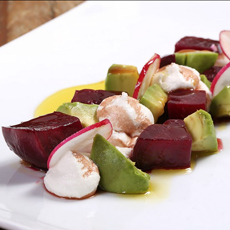
|
|
|
MODERN SALADS In the U.S. and Europe, salads of mixed greens salads (“green salads”) became popular in the late 19th century, and the concept expanded to Asia and other regions of the world. The term “salad bar,” referring to a buffet laid out with salad-making ingredients so customers could make their own, seems to date to the 1960s. Restaurants in different parts of the country lay claim to its invention, including New York City’s Steak & Ale and Hawaii’s Chuck’’s Steak House. The attraction was the ability to customize one’s salad—and eat as much as you wanted (more history). In truth, for centuries inns and boarding houses placed the food on a buffet for guests to help themselves (the “board” from “room and board”). ________________ †The phrase is found in Shakespeare’s Antony and Cleopatra at the end of Act 1, when Cleopatra regrets her youthful dalliances with Julius Caesar: “…My salad days, / When I was green in judgment, cold in blood…”. |
||
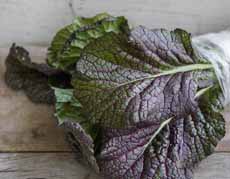
|
Mary, Queen of Scots (1542-1587) enjoyed salads of boiled celery root over greens. covered with creamy mustard dressing, truffles, chervil, and slices of hard-boiled eggs. The phrase “salad days,” meaning a “time of youthful inexperience,” i.e. a young person who is “green,” was coined by Shakespeare†, in 1606. Today, salads range far beyond the green salads (garden salads) of the 20th century—a concept so prevalent that in the U.S., the word salad unmodified (i.e., corn salad) refers to a green salad with torn, bite-size lettuce and other ingredients cut into small pieces. But there other options that are rightfully called “salad”: |
|
|
________________ ‡Instead of topping the salad with dressing, it’s trendy to cover the plate with dressing and place the salad on top of it.
|
||
